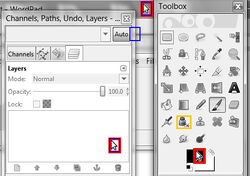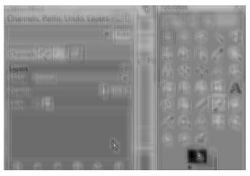Difference between revisions of "Example Template Matching"
m |
m |
||
| Line 11: | Line 11: | ||
Example Code: | Example Code: | ||
* [https://github.com/lessthanoptimal/BoofCV/blob/v0. | * [https://github.com/lessthanoptimal/BoofCV/blob/v0.20/examples/src/boofcv/examples/features/ExampleTemplateMatching.java ExampleTemplateMatching.java] | ||
Concepts: | Concepts: | ||
| Line 21: | Line 21: | ||
/** | /** | ||
* Example of how to find objects inside an image using template matching. Template matching works | * Example of how to find objects inside an image using template matching. Template matching works | ||
* well when there is little noise in the image and the object's appearance is known and static. | * well when there is little noise in the image and the object's appearance is known and static. It can | ||
* also be very slow to compute, depending on the image and template size. | |||
* | * | ||
* @author Peter Abeles | * @author Peter Abeles | ||
| Line 32: | Line 33: | ||
* @param image Image being searched | * @param image Image being searched | ||
* @param template Template being looked for | * @param template Template being looked for | ||
* @param mask Mask which determines | * @param mask Mask which determines the weight of each template pixel in the match score | ||
* @param expectedMatches Number of expected matches it hopes to find | * @param expectedMatches Number of expected matches it hopes to find | ||
* @return List of match location and scores | * @return List of match location and scores | ||
| Line 77: | Line 78: | ||
BufferedImage output = new BufferedImage(image.width, image.height, BufferedImage.TYPE_INT_BGR); | BufferedImage output = new BufferedImage(image.width, image.height, BufferedImage.TYPE_INT_BGR); | ||
VisualizeImageData.grayMagnitude(intensity, output, -1); | VisualizeImageData.grayMagnitude(intensity, output, -1); | ||
ShowImages.showWindow(output, "Match Intensity"); | ShowImages.showWindow(output, "Match Intensity", true); | ||
} | } | ||
| Line 83: | Line 84: | ||
// Load image and templates | // Load image and templates | ||
String directory = " | String directory = UtilIO.pathExample("template"); | ||
ImageFloat32 image = UtilImageIO.loadImage(directory | ImageFloat32 image = UtilImageIO.loadImage(directory ,"desktop.png", ImageFloat32.class); | ||
ImageFloat32 templateCursor = UtilImageIO.loadImage(directory | ImageFloat32 templateCursor = UtilImageIO.loadImage(directory , "cursor.png", ImageFloat32.class); | ||
ImageFloat32 maskCursor = UtilImageIO.loadImage(directory | ImageFloat32 maskCursor = UtilImageIO.loadImage(directory , "cursor_mask.png", ImageFloat32.class); | ||
ImageFloat32 templatePaint = UtilImageIO.loadImage(directory | ImageFloat32 templatePaint = UtilImageIO.loadImage(directory , "paint.png", ImageFloat32.class); | ||
// create output image to show results | // create output image to show results | ||
Revision as of 08:50, 9 November 2015
Template matching compares a smaller image (the template) against every possible location in a larger target image. A match is declared the fit score is a local peak and above a threshold. Typically template matching is only used in highly controlled environments and doesn't work to well in natural scenes. It's also extremely computationally expensive and larger images/templates are likely to take an excessive amount of time to process.
The example below is intended to demonstrate the strengths and weaknesses of template matching. For each template the number of matches returned needs to be specified. If the number of matches is known then the results are good in this example, but if too many are requested the some of the results are noise. The intensity image is shown for a match. Notice how ambiguous the results are.
Example Code:
Concepts:
- Template Matching
Example Code
/**
* Example of how to find objects inside an image using template matching. Template matching works
* well when there is little noise in the image and the object's appearance is known and static. It can
* also be very slow to compute, depending on the image and template size.
*
* @author Peter Abeles
*/
public class ExampleTemplateMatching {
/**
* Demonstrates how to search for matches of a template inside an image
*
* @param image Image being searched
* @param template Template being looked for
* @param mask Mask which determines the weight of each template pixel in the match score
* @param expectedMatches Number of expected matches it hopes to find
* @return List of match location and scores
*/
private static List<Match> findMatches(ImageFloat32 image, ImageFloat32 template, ImageFloat32 mask,
int expectedMatches) {
// create template matcher.
TemplateMatching<ImageFloat32> matcher =
FactoryTemplateMatching.createMatcher(TemplateScoreType.SUM_DIFF_SQ, ImageFloat32.class);
// Find the points which match the template the best
matcher.setTemplate(template, mask,expectedMatches);
matcher.process(image);
return matcher.getResults().toList();
}
/**
* Computes the template match intensity image and displays the results. Brighter intensity indicates
* a better match to the template.
*/
public static void showMatchIntensity(ImageFloat32 image, ImageFloat32 template, ImageFloat32 mask) {
// create algorithm for computing intensity image
TemplateMatchingIntensity<ImageFloat32> matchIntensity =
FactoryTemplateMatching.createIntensity(TemplateScoreType.SUM_DIFF_SQ, ImageFloat32.class);
// apply the template to the image
matchIntensity.process(image, template, mask);
// get the results
ImageFloat32 intensity = matchIntensity.getIntensity();
// adjust the intensity image so that white indicates a good match and black a poor match
// the scale is kept linear to highlight how ambiguous the solution is
float min = ImageStatistics.min(intensity);
float max = ImageStatistics.max(intensity);
float range = max - min;
PixelMath.plus(intensity, -min, intensity);
PixelMath.divide(intensity, range, intensity);
PixelMath.multiply(intensity, 255.0f, intensity);
BufferedImage output = new BufferedImage(image.width, image.height, BufferedImage.TYPE_INT_BGR);
VisualizeImageData.grayMagnitude(intensity, output, -1);
ShowImages.showWindow(output, "Match Intensity", true);
}
public static void main(String args[]) {
// Load image and templates
String directory = UtilIO.pathExample("template");
ImageFloat32 image = UtilImageIO.loadImage(directory ,"desktop.png", ImageFloat32.class);
ImageFloat32 templateCursor = UtilImageIO.loadImage(directory , "cursor.png", ImageFloat32.class);
ImageFloat32 maskCursor = UtilImageIO.loadImage(directory , "cursor_mask.png", ImageFloat32.class);
ImageFloat32 templatePaint = UtilImageIO.loadImage(directory , "paint.png", ImageFloat32.class);
// create output image to show results
BufferedImage output = new BufferedImage(image.width, image.height, BufferedImage.TYPE_INT_BGR);
ConvertBufferedImage.convertTo(image, output);
Graphics2D g2 = output.createGraphics();
// Search for the cursor in the image. For demonstration purposes it has been pasted 3 times
g2.setColor(Color.RED); g2.setStroke(new BasicStroke(5));
drawRectangles(g2, image, templateCursor, maskCursor, 3);
// show match intensity image for this template
showMatchIntensity(image, templateCursor, maskCursor);
// Now it's try finding the cursor without a mask. it will get confused when the background is black
g2.setColor(Color.BLUE); g2.setStroke(new BasicStroke(2));
drawRectangles(g2, image, templateCursor, null, 3);
// Now it searches for a specific icon for which there is only one match
g2.setColor(Color.ORANGE); g2.setStroke(new BasicStroke(3));
drawRectangles(g2, image, templatePaint, null, 1);
ShowImages.showWindow(output, "Found Matches",true);
}
/**
* Helper function will is finds matches and displays the results as colored rectangles
*/
private static void drawRectangles(Graphics2D g2,
ImageFloat32 image, ImageFloat32 template, ImageFloat32 mask,
int expectedMatches) {
List<Match> found = findMatches(image, template, mask, expectedMatches);
int r = 2;
int w = template.width + 2 * r;
int h = template.height + 2 * r;
for (Match m : found) {
// the return point is the template's top left corner
int x0 = m.x - r;
int y0 = m.y - r;
int x1 = x0 + w;
int y1 = y0 + h;
g2.drawLine(x0, y0, x1, y0);
g2.drawLine(x1, y0, x1, y1);
g2.drawLine(x1, y1, x0, y1);
g2.drawLine(x0, y1, x0, y0);
}
}
}

